Russian aircraft carrier Admiral Kuznetsov
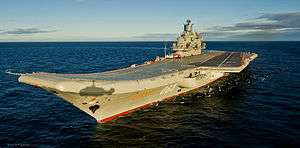 | |
| History | |
|---|---|
| Name: | Admiral Flota Sovetskogo Soyuza Kuznetsov (Russian: Адмирал Флота Советского Союза Кузнецов) |
| Namesake: | Nikolay Kuznetsov |
| Ordered: | 3 March 1981 |
| Builder: |
|
| Laid down: | 1 April 1982[1] |
| Launched: | 6 December 1985[1] |
| Commissioned: | (Fully operational in 1995) |
| Refit: | May–August 2015[3] July 2018–present[4] |
| Status: | Undergoing refit |
| General characteristics | |
| Class and type: | Kuznetsov-class aircraft carrier |
| Displacement: | |
| Length: | |
| Beam: | |
| Draft: | 10 m (33 ft)[1] |
| Propulsion: |
|
| Speed: | 29 knots (33 mph; 54 km/h)[1] |
| Range: | 8,500 nmi (15,700 km) at 18 kn (21 mph; 33 km/h)[1] |
| Endurance: | 45 days[1] |
| Complement: |
|
| Armament: |
|
| Aircraft carried: |
|
Admiral Flota Sovetskogo Soyuza Kuznetsov (Russian: Адмира́л фло́та Сове́тского Сою́за Кузнецо́в "Admiral of the Fleet of the Soviet Union Kuznetsov") is an aircraft carrier (heavy aircraft-carrying missile cruiser, or TAVKR, in Russian classification) serving as the flagship of the Russian Navy. She was built by the Black Sea Shipyard, the sole manufacturer of Soviet aircraft carriers, in Nikolayev within the Ukrainian Soviet Socialist Republic (SSR). The initial name of the ship was Riga; she was launched as Leonid Brezhnev, embarked on sea trials as Tbilisi, and finally named Admiral Flota Sovetskogo Soyuza Kuznetsov after Admiral of the fleet of the Soviet Union Nikolay Gerasimovich Kuznetsov.[8]
She was originally commissioned in the Soviet Navy, and was intended to be the lead ship of her class. However, her sister ship Varyag had neither been completed nor been commissioned when the Soviet Union collapsed in 1991.[9] The second hull was eventually sold by Ukraine to the People's Republic of China, completed in Dalian and commissioned as Liaoning.[10]
Role
The design of Admiral Kuznetsov-class implies a mission different from that of the United States Navy's carriers. The term used by her builders to describe the Russian ships is tyazholyy avianesushchiy kreyser (TAVKR) – "heavy aircraft-carrying cruiser" – intended to support and defend strategic missile-carrying submarines, surface ships, and naval missile-carrying aircraft of the Russian Navy.

Admiral Kuznetsov's main fixed-wing aircraft is the multi-role Sukhoi Su-33. It can perform air superiority, fleet defence, and air support missions and can also be used for direct fire support of amphibious assault, reconnaissance and placement of naval mines.[11] The carrier also carries the Kamov Ka-27 and Kamov Ka-27S helicopters for anti-submarine warfare, search and rescue, and small transport.
For take-off of fixed wing aircraft, Admiral Kuznetsov uses a ski-jump at the end of her bow. On take-off aircraft accelerate toward and up the ski-jump using their afterburners. This results in the aircraft leaving the deck at a higher angle and elevation than on an aircraft carrier with a flat deck and catapults. The ski-jump take-off is less demanding on the pilot, since the acceleration is lower, but results in a clearance speed of only 120–140 km/h (75–85 mph) requiring an aircraft design which will not stall at those speeds.[12] The "cruiser" role is facilitated by Admiral Kuznetsov's complement of 12 long-range surface-to-surface anti-ship P-700 Granit (NATO reporting name: Shipwreck) cruise missiles. As a result, this armament is the basis for the ship's Russian type designator of "heavy aircraft-carrying missile cruiser".
Transiting the Turkish Straits
Admiral Kuznetsov's designation as an aircraft cruiser is very important under international law, as it allows the ship to transit the Turkish Straits. The Montreux Convention prohibits Russia from sending an aircraft carrier heavier than 15,000 tons through the Straits. Since the ship was built in the Ukrainian SSR, Admiral Kuznetsov would have been stuck in the Black Sea if Turkey had refused permission to pass into the Mediterranean Sea.[13] The Convention does not limit the displacement of capital ships operated by Black Sea powers. Turkey has always allowed Admiral Kuznetsov to transit the Straits, and no other signatory to the Montreux Convention has ever issued a formal protest of her classification as an aircraft cruiser.[14]
History
1990s
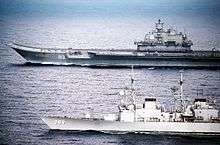
Admiral Flota Sovetskovo Soyuza Kuznetsov, constructed at Chernomorskiy Shipyard, also known as Nikolayev South Shipyard, in Nikolayev, now Mykolaiv, Ukrainian SSR, was launched in 1985, and became fully operational in 1995. An official ceremony marking the start of construction took place on 1 September 1982; in fact she was laid down in 1983. The vessel was first named Riga, then the name was changed to Leonid Brezhnev, this was followed by Tbilisi. Finally, on 4 October 1990,[9] she was renamed Admiral Flota Sovetskovo Soyuza Kuznetsov, referred to in short as Admiral Kuznetsov.[8] The ship was 71% complete by mid-1989. In November 1989 she undertook her first aircraft operation trials. In December 1991, she sailed from the Black Sea to join the Northern Fleet. Only from 1993 on did she receive aircraft.
From 23 December 1995 through 22 March 1996 Admiral Kuznetsov made her first 90-day Mediterranean deployment with 13 Su-33, 2 Su-25 UTG, and 11 helicopters aboard.[15] The deployment was to allow the carrier, which was accompanied by a frigate, destroyer and oiler, to adapt to the Mediterranean climate and to perform continuous flight operations until 21:00 each day, as the Barents Sea only receives about one hour of sunlight during this time of year.[16] This cruise marked the 300th anniversary of the Russian Navy celebrated in 1996. During that period the carrier lay at anchor off the port of Tartus, Syria.[17] Her aircraft often made flights close to the Israeli shore line and were escorted by Israeli F-16s.[17] During the deployment, a severe water shortage occurred due to evaporators breaking down.[16]
At the end of 1997 she remained immobilized in a Northern Fleet shipyard, awaiting funding for major repairs, which were halted when they were only 20% complete. The overhaul was completed in July 1998, and the ship returned to active service in the Northern fleet on 3 November 1998.
2000–2010
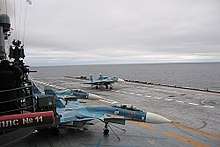
Admiral Kuznetsov remained in port for two years before preparing for another Mediterranean deployment scheduled for the winter of 2000–2001. This deployment was cancelled due to the explosion and sinking of the nuclear-powered submarine Kursk. Admiral Kuznetsov participated in the Kursk rescue and salvage operations in late 2000. Plans for further operations were postponed or cancelled. In late 2003 and early 2004, Admiral Kuznetsov went to sea for inspection and trials. In October 2004, she participated in a fleet exercise of the Russian Navy in the Atlantic Ocean.[18] During a September 2005 exercise, an Su-33 accidentally fell from the carrier into the Atlantic Ocean.[19] On 27 September 2006, it was announced that Admiral Kuznetsov would return to service in the Northern Fleet by the year's end, following another modernization to correct some technical issues. Admiral Vladimir Masorin, Commander-in-Chief of the Russian Navy, also stated that Su-33 fighters assigned to her would return after undergoing their own maintenance and refits.
From 5 December 2007 through 3 February 2008 Admiral Kuznetsov made its second Mediterranean deployment.[15] On 11 December 2007, Admiral Kuznetsov passed by Norwegian oil platforms in the North Sea, 60 nautical miles (110 km) outside Bergen, Norway.[20] Su-33 fighters and Kamov helicopters were launched from Admiral Kuznetsov while within international waters; Norwegian helicopter services to the rigs were halted due to the collision risk with the Russian aircraft. Admiral Kuznetsov later participated in an exercise on the Mediterranean Sea, together with 11 other Russian surface ships and 47 aircraft, performing three tactical training missions using live and simulated air and surface missile launches.[21] Admiral Kuznetsov and her escorts returned to Severomorsk on 3 February 2008. Following maintenance, she returned to sea on 11 October 2008 for the Stability-2008 strategic exercises held in the Barents Sea. On 12 October 2008, Russian President Dmitry Medvedev visited the ship during the exercise.
From 5 December 2008 through 2 March 2009, Admiral Kuznetsov made her third Mediterranean deployment.[15] On 5 December 2008, she and several other vessels left Severomorsk for the Atlantic for a combat training tour, including joint drills with Russia's Black Sea Fleet and visits to several Mediterranean ports.[22][23] On 7 January 2009, a small fire broke out onboard Admiral Kuznetsov while anchored off Turkey. The fire, caused by a short-circuit, led to the death of one crew member by carbon monoxide poisoning.[24] On 16 February 2009, she was involved in a large oil spill, along with other Russian naval vessels, while refuelling off the south coast of Ireland.[25] On 2 March 2009, Admiral Kuznetsov returned to Severomorsk, and on September 2010 she left dry dock after scheduled repairs and preparations for a training mission in the Barents Sea, later that month.
2011–12 Mediterranean deployment
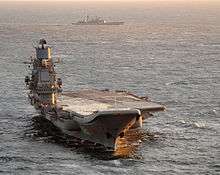
The Russian Main Navy Staff announced that Admiral Kuznetsov would begin a deployment to the Atlantic and Mediterranean in December 2011. In November 2011, it was announced that Admiral Kuznetsov would lead a squadron to Russia's naval facility in Tartus.[26][27]
A Russian naval spokesman announced via the Izvestia daily that "The call of the Russian ships in Tartus should not be seen as a gesture towards what is going on in Syria... This was planned already in 2010 when there were no such events there" noting that Admiral Kuznetsov would also be making port calls in Beirut, Genoa and Cyprus.[28] On 29 November 2011, Army General Nikolay Makarov, Chief of the Russian General Staff, said that Russian ships in the Mediterranean were due to exercises rather than events in Syria, and noted that Admiral Kuznetsov's size does not allow it to moor in Tartus.[29]

On 6 December 2011, Admiral Kuznetsov and her escort ships departed the Northern Fleet homebase for a Mediterranean deployment to exercise with ships from the Russian Baltic and Black Sea Fleets.[30] On 12 December 2011 Admiral Kuznetsov and her escorts, were spotted northeast of Orkney off the coast of northern Scotland, the first such time she had deployed near the UK. HMS York (D98) shadowed the group for a week; due to severe weather, the group took shelter in international waters in the Moray Firth, some 30 miles from the UK coast. Admiral Kuznetsov then sailed around the top of Scotland and into the Atlantic past western Ireland, where she conducted flight operations with her Sukhoi Su-33 'Flanker' jets and Kamov Ka-27 helicopters in international airspace.[31] On 8 January 2012, Admiral Kuznetsov anchored near shore outside Tartus while other ships from her escort entered the port to use the leased Russian naval support facility to replenish their supplies, after which all ships continued their deployment on 9 January.[32] On 17 February 2012, Admiral Kuznetsov returned to her homebase of Severomorsk.
2013–14 deployment
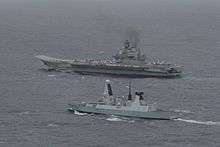
On 1 June 2013, it was announced that the ship would return to the Mediterranean by the end of the year,[33] and on 17 December, Admiral Kuznetsov departed her homebase for the Mediterranean.[34] On 1 January 2014, Admiral Kuznetsov celebrated New Year's Day while at anchor in international waters of the Moray Firth off northeast Scotland. The anchorage allowed replenishment of ship's supplies and respite for the crew from stormy weather off the southwest coast of Norway. She then proceeded to the Mediterranean Sea,[35] docking in Cyprus on 28 February.[36] In May 2014, the ship and her task group: the Kirov-class nuclear-powered cruiser Petr Velikiy; tankers; Sergey Osipov, Kama and Dubna; ocean-going tug Altay and Ropucha-class landing ship Minsk (a part of the Black Sea Fleet), passed the UK while sailing for home.[37] Despite financial and technical problems, resulting in limited operations for the ship,[38] it is expected that Admiral Kuznetsov will remain in active service until at least 2030.[39]
Mid-life refit
In April 2010, it was announced that by late 2012, the ship would enter Severodvinsk Sevmash shipyard for a major refit and modernization,[40] including upgrades to obsolete electronics and sensor equipment, installation of a new anti-aircraft system (Pantsir-M) and an increase of the air wing with the removal of the P-700 Granit anti-ship missiles. Possible upgrades include exchanging the troublesome steam powerplant to gas-turbine, or even nuclear propulsion, and installation of catapults to the angled deck.[40]
The Navy expected to acquire Mikoyan MiG-29K aircraft for Admiral Kuznetsov by 2011; this later was confirmed by a defense sub-contractor[41][42] The MiG-29Ks would replace the 19 carrier-based Su-33 fighters, a resource set to expire by 2015. Producing more Su-33s is possible but not cost-effective for such small volumes; the MiG-29K is more convenient as the Indian Navy also placed an order a total for 45, reducing development and manufacture costs. India paid $730 million for the development and delivery of 16 MiG-29Ks; 24 more for the Russian Navy would cost about $1 billion.[41]
2016 Syrian campaign
Following ongoing maintenance, Admiral Kuznetsov set sail on 15 October 2016 from the Kola Bay for the Mediterranean, accompanied by seven other Russian Navy vessels including the nuclear-powered battlecruiser Pyotr Velikiy and two Udaloy-class destroyers.[43][44] The carrier was accompanied by an ocean-going tugboat, as a precaution due to potential propulsion failure.[45][46][47] The airwing included 6-8 Su-33 fighters,[48] four Mig-29KR/KUBR multi-role aircraft,[49] Ka-52K "Katran" navalised attack helicopters, Ka-31R "Helix" AEW&C helicopters and Ka-27PS "Helix-D" search and rescue helicopters.[50] All the Su-33 aircraft had been upgraded with the Gefest SVP-24 bombsights for free-fall bombs, giving them a limited ground-attack capability.[48] Analysts, including Mikhail Barabanov of the Moscow Defense Brief, suggested that a lack of trained pilots restricted the number of fixed-wing aircraft that could be deployed from the carrier.[51]
On 21 October, the Admiral Kuznetsov battle group sailed through the English Channel, escorted by Royal Navy ships, while UK Defence Minister Michael Fallon speculated that the taskforce was designed to "test" the British naval response.[52] On 26 October 2016, the ship was reported to have passed through the Strait of Gibraltar[53] and refuelled at sea off North Africa the following day.[54] On 3 November 2016, the Admiral Kuznetsov battle group paused off the east coast of Crete.[55] On 14 November 2016, a MiG-29K crashed into the sea after taking off from the carrier. The pilot ejected safely from the plane and was rescued by helicopter. According to initial reports from Russian officials, the crash was a result of technical malfunction,[56][57] but it was later revealed that the plane had actually run out of fuel waiting to land while the crew was attempting to repair a broken arresting wire. The carrier commander could have diverted the aircraft to land at a nearby airbase, but hesitated in the hope that the arrestor gear would be repaired in time.[58]
On 15 November 2016, Admiral Kuznetsov, took part in "a large-scale operation against the positions of terrorist groups Islamic State and Al-Nusra, in the provinces of Idlib and Homs" in Syria by launching Su-33 fighter strikes. This was the first time a Russian aircraft carrier would take part in combat operations.[59] Russian Defence Ministry later reported that 30 militants had been killed as a result of those strikes, including 3 field commanders, among them Abul Baha al-Asfari, leader of Al-Nusra reserves in the provinces of Homs and Aleppo. Al-Asfari had also planned and led several insurgent attacks on the city of Aleppo itself. The Su-33s reportedly used 500-kg precision bombs.[60][61] On 3 December 2016, an Su-33 crashed into the sea after attempting to land on the carrier. The plane crashed on its second attempt to land on the aircraft carrier in good weather conditions. The pilot was safely recovered by a search and rescue helicopter.[62] Initially it was suspected that the plane missed the wires and failed to go around, falling short of the bow of the warship, but later it was revealed that the arresting cable failed to hold the aircraft, and was damaged in the attempt. Following the two incidents, the air wing was transferred to shore at Khmeimim Air Base near Latakia, Syria to continue military operations while the carrier's arresting gear issues were addressed.[63]
Post Syrian operations
In early January 2017, it was announced that Admiral Kuznetsov and her battlegroup would be ceasing operations in Syria and returning to Russia as part of a scaling back of Russian involvement in the conflict.[64] During her deployment off Syria, aircraft from Admiral Kuznetsov carried out 420 combat missions, hitting 1,252 hostile targets.[65] On 11 January 2017, Admiral Kuznetsov was conducting live-fire training exercises in the Mediterranean off the coast of Libya.[66] The Russian defence ministry announced that on 11 January, Admiral Kuznetsov was visited by Libya′s military leader Khalifa Haftar, who had a video conference with Russian defence minister Sergey Shoygu while on board.[67][68]
On 20 January Admiral Kuznetsov was sighted passing west through the Strait of Gibraltar and six days later she was escorted back along the English Channel by three Eurofighter Typhoons of the Royal Air Force and the Type 23 frigate HMS St Albans (F83).[69] She arrived back in Severomorsk on 9 February.[70] On 23 February 2017, President Putin said that the ship′s deployment to the Mediterranean had been his personal initiative.[71][72] The carrier started an overhaul and modernisation in the first quarter of 2017. This is expected to extend its service life by 25 years.[73]
The Admiral Kuznetsov is expected to undergo modernization at the 35th Ship Repair Plant in Murmansk between 2020 and 2021, upgrading the ship's power plant and electronics systems.[74]
See also
Notes
References
- 1 2 3 4 5 6 7 8 9 10 11 12 13 Yu.B. Apalkov, Korabli VMF SSSR, Tom 2, Udarnye Korabli, Galeya Print, Sankt Peterburg, 2003
- ↑ "Soviet Naval Aviation increasing - U.S. Navy spy chief; Kutzenow carrier should deploy this year". Defense Daily. 11 March 1991. Retrieved 8 August 2015 – via HighBeam Research. (Subscription required (help)).
- ↑ "Russia's Admiral Kuznetsov Aircraft Carrier is Back in Service!". Sputnik. 20 August 2015. Retrieved 20 August 2015.
- ↑ ""Адмирал Кузнецов" в ремонте". bmpd.livejournal.com. 23 July 2018. Retrieved 23 July 2018.
- ↑ Admiral Kuznetsov the only aircraft carrier in the Russian Navy Archived 29 August 2010 at the Wayback Machine.
- ↑ "Морская авиация ВМФ РФ в этом году пополнится 12 самолетами". flotprom.ru (in Russian). 5 September 2014. Retrieved 21 August 2017.
- 1 2 Sovetskii Avianostsy, S.Balakin & V.Zablotskiy, Moscow 2007
- 1 2 Korabli VMF SSSR" (USSR Navy Ships), Yu.V. Apalkov, Galeya Print, Sankt Peterburg, 2003
- ↑ ""China's Aircraft Carrier Ambitions: Seeking Truth from Rumors" Archived 12 December 2006 at the Wayback Machine.. Storey, I.; Ji, Y. Naval War College Review. Winter 2004, Vol. 57, No. 1.
- ↑ KnAAPO. "The Su-33 single-seat carrier-based fighter" Archived 16 July 2011 at the Wayback Machine..
- ↑ Gordon, Yefim & Davidson, Peter. 2006. "Sukhoi Su-27 Flanker", p. 54. Warbird Tech Series, vol. 42. ISBN 978-1-58007-091-1.
- ↑ Miller, David V.; Hine, Jr., Jonathan T. (31 January 1990). Soviet Carriers in the Turkish Straits (PDF). Newport, Rhode Island: Naval War College.
- ↑ John Pike. "Montreux Convention 1936". Globalsecurity.org. Retrieved 2013-07-20.
- 1 2 3 http://www.mil.ru
- 1 2 Almond, Peter (11 January 1996). "U.S. Poised to Rescue Russian Sailors". Washington Post. Retrieved 8 May 2015 – via HighBeam Research. (Subscription required (help)).
- 1 2 Encounters of the Russian Kind, IAF journal no. 145., June 2002 (in Hebrew)
- ↑ Pavel Felgenhauer, "A Foolhardy Naval Exercise" Archived 7 November 2004 at the Wayback Machine., Moscow Times. Critical article about the fall 2004 exercise in which Admiral Kuznetsov participated.
- ↑ "Затонувший Су-33 бомбить не будут - он разрушится сам". Lenta.ru. 7 September 2005. Retrieved 10 June 2015.
- ↑ Klungtveit, Harald S.; Gulseth, Hege Løvstad (11 December 2007). "Russiske jagerfly lager kaos i Nordsjøen" (in Norwegian). Retrieved 18 September 2008.
- ↑ Terje Solsvik; Wojciech Moskwa (11 December 2007). "Russian navy disrupts [sic] access to N.Sea oilfields". reuters.com. Retrieved 28 April 2012.
- ↑ "Russian warships head to Atlantic, Mediterranean". Moscow. AP. 5 December 2008. Retrieved 9 December 2008.
- ↑ "Russian naval task force heads to Atlantic, Mediterranean". Moscow. RIA Novosti. 5 December 2008. Retrieved 9 December 2008.
- ↑ Sailor killed in fire on board Russian warship off Turkey – 2 | Russia | RIA Novosti
- ↑ TimesOnline.co.uk Huge oil slick from Russian ship heads for British coastline, Accessed 17 February 2009.
- ↑ "Russia sent military ships to base in Syria". Hotspots and Incidents – Terrorism. Pravda. 30 November 2011. Archived from the original on 1 December 2011. Retrieved 1 December 2011.
- ↑ Thomas Grove (28 November 2011). "Russia sending warships to its base in Syria". Africa. Rueters. Retrieved 1 December 2011.
- ↑ Russia to send warships to Syria in 2012: report
- ↑ Interfax, Moscow 1250 GMT 29 Nov 11
- ↑ RIA Novosti 6 Dec 2001 1121GMT
- ↑ "York completes a week shadowing Russia's biggest warship around the British Isles" Archived 23 April 2012 at the Wayback Machine. Royal Navy Press Release, 22 December 2011
- ↑ Russian news agency INTERFAX 8 January 2012
- ↑ "Admiral Kuznetsov aircraft carrier to start long-range mission in Mediterranean in late 2013". Russia Beyond The Headlines. 1 June 2013. Retrieved 2 June 2013.
- ↑ http://tvzvezda.ru/news/forces/content/201312171348-ad8c.htm
- ↑ Russia TV station ZVEZDA
- ↑ "Archived copy". Archived from the original on 1 March 2014. Retrieved 13 March 2014.
- ↑ "Royal Navy sails to meet Russian Task Group". UK: Royal Navy. 8 May 2014. Retrieved 2 April 2018.
- ↑ "Advancing, blindly". The Economist. 18 September 2008. Retrieved 18 September 2008.
- ↑ Russia plans new life for naval assets Extract from Jane's, August 2006 Archived 1 February 2009 at the Wayback Machine.
- 1 2 "Moscow set to upgrade Admiral Kuznetsov aircraft carrier". RIA Novosti. 6 April 2010. Retrieved 7 April 2010.
- ↑ Trude Pettersen (25 September 2009). "New fighter jets for Admiral Kuznetsov". BarentsObserver.com. Archived from the original on 7 July 2011. Retrieved 28 April 2012.
- ↑ "Авианосная группа кораблей Северного флота начала поход в Средиземное море". RIA Novosti. 15 October 2016. Retrieved 15 October 2016.
- ↑ Ripley, Tim (17 October 2016). "Russian carrier sails for the Mediterranean". IHS Jane's 360. Jane's. Archived from the original on 18 October 2016. Retrieved 17 October 2016.
- ↑ "Belching smoke through the Channel, Russian aircraft carrier so unreliable it sails with its own breakdown tug". The Telegraph. 22 October 2016. Retrieved 23 October 2016.
- ↑ "Russian Aircraft Carrier Smokes Through English Channel". Defensetech. 2016-10-21. Retrieved 2017-07-02.
- ↑ "Take a Stomach-Churning Ride on a Russian Navy Tugboat". Popular Mechanics. 2015-11-10. Retrieved 2017-07-02.
- 1 2 "'Sea Flankers' prepare for Syria". Combat Aircraft. 30 September 2016.
- ↑ "Russian Navy MiG-29K lost in Mediterranean". Combat Aircraft. 14 November 2016.
- ↑ "Carrier-based Ka-52K bound for Syria", Combat Aircraft, 21 October 2016
- ↑ Majumdar, Dave (19 September 2016). ""Russia's Only Aircraft Carrier Is Headed For Syria (But Suffers From One Big Flaw)"". The National Interest. Retrieved 16 November 2016.
- ↑ "Russian warships escorted through English Channel by British navy on their way to Syria". The Independent. 21 October 2016. Retrieved 28 October 2016.
- ↑ "Russia withdraws request for carrier battle group to refuel in Spain amid NATO pressure on Madrid". RT. 26 October 2016. Retrieved 28 October 2016.
- ↑ "Russia warships: Admiral Kuznetsov battle group 'refuels off North Africa'". BBC. 27 October 2016. Retrieved 28 October 2016.
- ↑ "Ominous news for Aleppo as Russian frigate reaches Syrian coast". The Guardian. 4 November 2016. Retrieved 6 November 2016.
- ↑ https://www.bbc.com/news/world-middle-east-37978463
- ↑ http://www.foxnews.com/world/2016/11/14/russian-fighter-jet-crashes-near-its-aircraft-carrier-in-mediterranean-us-officials-say.html
- ↑ Russia’s Carrier Operations Start with Mishaps - Ainonline.com, 5 December 2016
- ↑ "Russian carrier takes part in massive strikes on terrorists in Syria's Idlib & Homs provinces – MoD". RT International. Retrieved 2016-11-15.
- ↑ 3 Nusra commanders, dozens of jihadists killed in airstrikes from Russian aircraft carrier – MoD RT, 17 November 2016
- ↑ "Commander of Syrian radical group killed in Russia's strikes - Xinhua | English.news.cn". news.xinhuanet.com. Retrieved 2017-04-13.
- ↑ "Russian Su-33 crashed in the Mediterranean while attempting to land on Admiral Kuznetsov aircraft carrier". The Aviationist. 2016-12-05. Retrieved 2016-12-05.
- ↑ "Russian Combat Jets To Operate From Syria Airbase Following Carrier Landing Malfunction". Defense World.net. 6 Dec 2016. Retrieved 6 Dec 2016.
- ↑ "Russia scales down military presence in Syria, Admiral Kuznetsov aircraft carrier to leave first". RT International. Retrieved 2017-01-10.
- ↑ Vasilescu, Valentin (16 January 2017). "17-Jan-17 In Syria, The Russian Navy And Air Force Are Testing New Means Of Defense Against An Invasion By NATO". Retrieved 13 April 2017.
- ↑ "Russia steps up military presence in Syria, despite Putin promise". FoxNews.com. Fox News. 11 January 2017.
- ↑ Командующий Ливийской национальной армией посетил "Адмирал Кузнецов" RIA Novosti.
- ↑ East Libya strongman visits Russian aircraft carrier in Mediterranean: RIA Reuters
- ↑ "UK warship escorts Russian carrier in English Channel". BBC. 25 January 2017. Retrieved 25 January 2017.
- ↑ В Североморске помпезно встретили "Адмирала Кузнецова" и "Петра Великого", вернувшихся из сирийского похода (ВИДЕО) NEWSru, 9 February 2017.
- ↑ Путин назвал сирийский поход «Адмирала Кузнецова» личной инициативой
- ↑ Путин назвал поход «Адмирала Кузнецова» в Сирию личной инициативой
- ↑ Soper, Karl (1 August 2016). "Admiral Kuznetsov overhaul designed to maintain carrier capability while Russia considers future carrier options". Jane's Navy International. Surrey, UK: Jane's Information Group. 121 (6). ISSN 1358-3719.
- ↑ Johnson, Reuben F. (April 26, 2018). "Russian Navy to upgrade Kuznetsov". Jane's Information Group.
The modernisation work is to be carried out by the 35th Ship Repair Plant in Murmansk, which is a satellite facility of the Zvezdochki Ship Repair Centre in Severodvinsk. Russia's deputy defence minister for procurement, Yuri Borisov, stated in April that the entire re-fit would be complete by the end of 2020 and the ship back in service in 2021.
External links
| Wikimedia Commons has media related to Admiral Kuznetsov. |